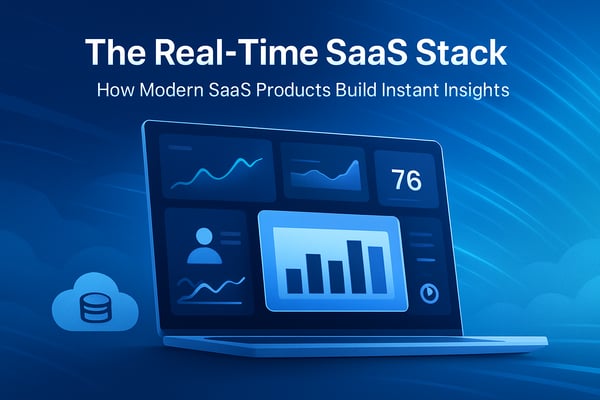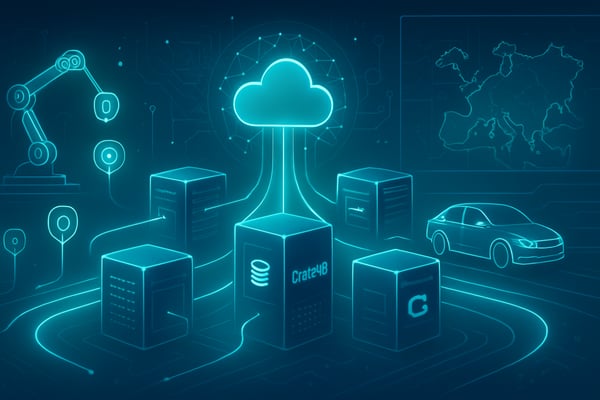Selecting the right big data database has become a strategic decision for organizations that depend on instant insights, high-volume data, and fast operational workflows. With data coming from sensors, applications, logs, user interactions, and AI systems, a database must do more than store information. It must deliver real-time analytics at scale while supporting a mix of structured, semi-structured, and unstructured data.
This guide explains what sets a modern big data database apart and how to choose the right one for your real-time needs.
What Is a Big Data Database?
A big data database is a distributed system designed to store, index, and query massive volumes of structured, semi-structured, and unstructured data while maintaining high performance. It scales horizontally, supports continuous ingestion, and delivers analytics on rapidly growing datasets without slowing down. Modern platforms must manage everything from time series and documents to text, logs, geospatial data, and vectors in a single environment.
What Makes a Big Data Database Suitable for Real-Time Analytics?
A big data database is designed to handle massive datasets with high ingestion rates and immediate query readiness. For real-time analytics, it must offer:
Scalable, distributed architecture: A scale-out architecture spreads data and compute across multiple nodes, enabling fast queries and resilient operations even as data volumes surge.
High-throughput ingestion: The database must ingest millions of records per second without backpressure or delays that slow down analytics.
Support for all data types: Modern workloads blend time series, documents, logs, events, text, geospatial data, and vectors. A future-proof system handles all of them in one place.
Real-time indexing: Fresh data must be searchable within milliseconds so teams can react instantly to what’s happening.
Low latency queries: Analytics, aggregations, filtering, and search must remain fast even as datasets grow into billions of rows.
Why Traditional Databases Are Not Enough
Most legacy relational systems were built for predictable schemas and moderate workloads. They typically fall short when confronted with:
- High-frequency sensor or event data
- Frequent schema evolution
- Mixed workloads (analytics plus search)
- Unstructured text and documents
- Millisecond-level freshness requirements
This is why organizations move to more flexible, distributed big data databases that can power real-time decision making.
Benefits of a Modern Big Data Database
A next-generation big data database delivers clear advantages:
- Faster decision making with real-time insights
- Simplified architecture that avoids multiple specialized systems
- Lower operational cost through consolidation
- AI readiness through native vector search and hybrid retrieval
- High availability and resilience at scale
Core Capabilities to Evaluate
When choosing a big data database for real-time analytics, use the following criteria:
Horizontal scalability: Ensure the database can add capacity by simply adding nodes, without complex reconfiguration.
Unified workload support: Look for platforms that combine analytics, search, and AI workloads in a single engine. This reduces system sprawl and operational overhead.
Advanced indexing: Support for inverted indexes, columnar storage, and vector indexes ensures fast queries across all data types.
SQL compatibility: SQL remains the most universal language for analytics. A modern system should provide full SQL support even when working with documents, time-series records, or vector embeddings.
Real-time performance: The system must deliver sub-second response times for queries, aggregations, and search operations.
High availability and resilience: Features like sharding, replication, and automatic failover guarantee continuous operation and data durability.
AI-readiness: Look for built-in support for vector search, hybrid search, and real-time feature pipelines.
Matching Databases to Use Cases
Not all big data technologies suit every scenario. Consider these common real-time analytics use cases:
Industrial IoT and manufacturing: Machine data, sensor telemetry, and operational metrics require high ingestion rates and ultra-fast aggregations.
Mobility and logistics: Geospatial queries, fleet tracking, and route optimization rely on geospatial indexing and real-time location analytics.
Cybersecurity and monitoring: Threat detection, anomaly spotting, and log analysis demand low latency and rapid search across unstructured data.
AI-powered applications: Platforms need to store embeddings, run vector similarity search, and deliver hybrid retrieval for semantic workloads.
How to Choose the Best Fit
When evaluating candidates, ask:
- Can it ingest and query large datasets instantly?
- Does it support real-time dashboards and alerts?
- Can it scale horizontally without downtime?
- Does it combine structured, semi-structured, text, and vector workloads in one system?
- Will it reduce operational complexity compared to using multiple databases?
-
Is it cost-effective at scale?
The right big data database should simplify your architecture while accelerating insights across your business.
Hadoop and Its Legacy in Big Data
For many years, Hadoop was the foundation of big data processing. It introduced a distributed storage layer (HDFS) and a batch-oriented compute model (MapReduce) that allowed organizations to work with datasets too large for traditional systems. While Hadoop played a major historical role, it was not designed for real-time analytics or low-latency workloads. Most modern platforms have moved away from heavyweight Hadoop deployments toward faster, more flexible distributed databases and cloud services.
Today, Hadoop remains relevant in a few cases where large-scale batch processing or archival storage is required, but it is no longer the primary choice for teams building real-time analytics pipelines.
Comparing Leading Big Data Database Vendors
The big data ecosystem offers many technologies, each optimized for different workloads. Understanding the landscape helps narrow your selection to a platform that aligns with your real-time analytics needs. Here is a high-level overview of the main categories and their representative vendors.
Distributed SQL Databases
These offer the familiarity of SQL with the horizontal scale required for large-scale analytics.
- CrateDB for real-time analytics, search, and AI workloads with multi-model support in one engine
- CockroachDB for transactional workloads and global consistency
- YugabyteDB for OLTP-focused distributed SQL
They shine when organizations want SQL flexibility across high-volume datasets without managing traditional monolithic servers.
NoSQL Wide-Column Databases
Optimized for scalable, high-write scenarios, often at the expense of analytical query speed.
- Apache Cassandra for high availability and globally distributed writes
- HBase for large-scale, column-oriented storage over Hadoop ecosystems
These are strong for event streams and telemetry but often require numerous complementary systems for search and analytics.
Search and Log Analytics Engines
Used for high-speed search across text, logs, and operational telemetry.
- Elasticsearch for full-text search and log analytics
- OpenSearch as an open-source search and analytics suite
There is often a trade-off: excellent search performance, with higher operational complexity and limited SQL analytics.
Time Series Databases
Designed for metrics, monitoring, and sensor data.
- InfluxDB for time-stamped data and dashboards
- TimescaleDB which extends PostgreSQL with time-series capabilities
These excel with time-based patterns but are usually insufficient for mixed workloads involving text, geospatial, or vector embeddings.
Data Warehouses and Lakehouses
Built for large-scale batch analytics rather than real-time operations.
- Snowflake for scalable cloud analytics
- Databricks for lakehouse processing and AI pipelines
- BigQuery for serverless data warehousing
These platforms are powerful but generally not optimized for low-latency operational analytics or millisecond ingestion-to-query pipelines.
Vector Databases
Focused on AI and semantic search workloads.
- Pinecone for embeddings and vector similarity
- Weaviate and Qdrant for standalone vector search engines
They handle AI use cases well but require pairing with additional databases for traditional analytics and search.
Where Unified Platforms Fit In
A newer category of big data database vendors merges analytics, search, time series, and vectors into a single distributed SQL engine. These reduce system sprawl and simplify architectures by avoiding the need for multiple specialized databases stitched together. CrateDB belongs to this category.
This unified approach is becoming increasingly attractive for teams building real-time analytics and AI applications that mix structured data, documents, logs, geospatial information, and vector embeddings.
Conclusion
A modern big data database is essential for powering real-time analytics and supporting the next generation of AI-driven applications. As data volumes and velocity continue to grow, organizations need platforms that deliver speed, scalability, and flexibility in a single solution. By evaluating scalability, workload breadth, indexing capabilities, query performance, and AI readiness, you can choose a database that supports real-time intelligence and strengthens your long-term data strategy.
Learn more about how CrateDB can be used for your Big Data database.


